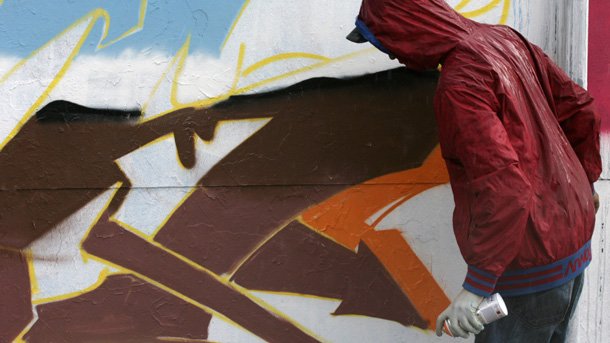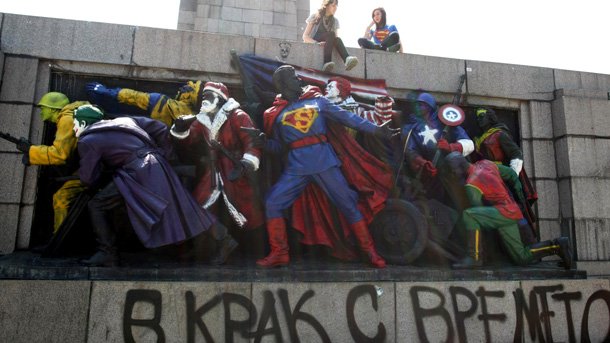Graffiti artists appeared in the middle of the 20th century. Nowadays many people might find even the co-existence of both words – “graffiti” and “artists”, unacceptable. On the other hand, however, we must admit that the ugly and rude scratching on the walls has turned into quite nice and even complex colorful paintings over the past years. People, of course, react in a different manner to those “drawings”- they are either tolerant and try to analyze the messages, hidden behind them, or deny the existence of this specific kind of art:
“We can say that graffiti is quite an active art – young Bulgarian artist Penka Mincheva says. – Its main advantages – it can be seen in the streets and so the access to it is an eased one. Perhaps graffiti paintings have something to do with posters, since the idea is some information to be given that can be perceived with a glance only. I think graffiti are really successful in that. On the other hand, they show the presence of an entire generation. In my opinion such drawings might even find their place in art galleries, Penka Mincheva goes on to say. I have seen similar projects - although those were not exactly graffiti - painted right on the walls of foreign galleries. Another subject might find its place, wherever contemporary art is studied too. I think a parallel is possible between classic art and contemporary one, presented by graffiti. It could be a good combination within the artistic environment of the galleries. At the same time outside, in the streets, graffiti bring their messages and sometimes those are even further developed – several authors continue to draw a graffito periodically, thus prolonging its life.”

© Photo: BGNES
Some of the graffiti artists were distinguished yet with the appearance of the first graffiti in the USA and Western Europe back in the 60s and 70s. Those turned into idols of the young people then. American artist Jean-Michel Basquiat was pronounced to be “the father of graffiti”. He was a part of a different and really extravagant cultural reality in the USA. Nowadays there are also Bulgarian artists with serious attitude towards this kind of art. An exhibition of the best graffiti artist Nasimo was presented in the spring in Sofia’s 1908 Gallery. The young man was later invited to Canada to show his works of art – paintings, sculptures, videos and body art pictures. It all comes as a proof that graffiti drawing, called a “street art” till recently develops more and more and people start seeing its messages. A peculiar event caused another discussion on the subject this summer. The Monument to the Soviet Army, situated downtown Sofia, woke up one morning painted all over by an unknown artist. The sculptures of the warriors with guns in their hands were colored in a very skilful manner and turned into popular American cartoon characters. There was a serious media discussion within the next few days, sociologists also expressed different opinions. The spot around the monument was visited by many people for a first time over the last years and those were really interested to see the “graffiti thing”:

© Photo: BGNES
“I did like those painted figures and felt regrets, when the paint was removed with some sort of a scandal – artist Penka Mincheva goes on to say. – I think there is nothing wrong with bringing a work of art back to life with another meaning. Of course, there were many controversies as the new symbols came from a different culture and perhaps some of the defenders of the monument had their right. However, I think one thing became clear in the whole situation – that there was a lack of spots, where graffiti artists could express their opinion. It also brings us to the lack of funds. If the unknown author of the paintings could afford a replica of the sculptures, placed in a gallery, the whole story would have had a different end, I am sure. A special spot like this could be for instance some sort of a graffiti festival, where both Bulgarian and foreign artists could meet their audience and share experience. At the same time spectators could observe the process of painting itself. However, graffiti are usually a spontaneous decision and that is why the places chosen most often suit the drawings.”
English version: Zhivko Stanchev
Turning a new page, 2025 comes with hope and faith in better days, in peace that will prevail, in happiness and love. On the first day of January - Golyam Sechko, as it is known in the Bulgarian tradition - the mood is upbeat and smiles are everywhere...
"Thank you to Petar Angelov, Michaela Velichkova, Sonia Chakarova and all the members of the representative folklore ensemble Shevitsa for the wonderful performance they gave to the people of Tsaribrod on the occasion of the upcoming holidays," wrote..
The Natalia Simeonova Foundation has filed documents for registration of a community center that will be named after the legend of Bulgarian rock music Kiril Marichkov . This was announced to the Bulgarian National Radio by the former host of one of the..
All necessary measures have been taken to protect the exhibits of the "Ancient Thrace and the Classical World: Treasures from Bulgaria, Romania and..
An exhibition titled "PICASSO: Graphics from the National Gallery Collection " will open at 18:00 pm this evening at Kvadrat 500 in Sofia. The..
Bulgaria's Consul General in New York Angel Angelov has taken part in an online discussion organized by an educational platform on Holocaust issues and..

+359 2 9336 661
